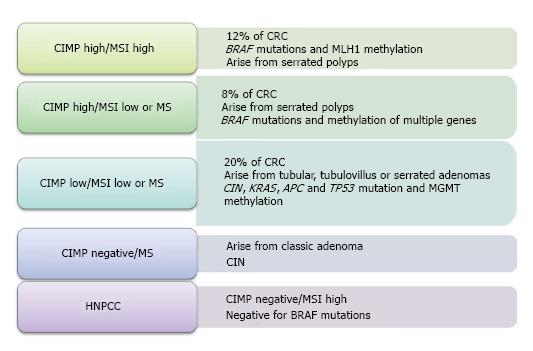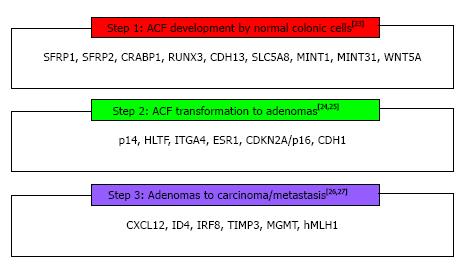Copyright
©The Author(s) 2017.
World J Gastrointest Oncol. Apr 15, 2017; 9(4): 142-152
Published online Apr 15, 2017. doi: 10.4251/wjgo.v9.i4.142
Published online Apr 15, 2017. doi: 10.4251/wjgo.v9.i4.142
Figure 1 Molecular classification of colorectal cancer.
The figure shows the different molecular profile and clinic-histopathological characteristics of each classification. CIMP: CpG island methylator phenotype; MSI: Microsatellite instability; MS: Microsatellite stability; CRC: Colorectal cancer; CIN: Chromosomal instability; HNPCC: Hereditary nonpolyposis colorectal cancer; MGMT: O-6-methylguanine-DNAmethyltransferase; BRAF: v-raf murine sarcoma viral oncogene homologe B1; MLH1: MutL homolog 1; KRAS: Kirsten rat sarcoma 2 viral oncogene homolog; APC: Adenomatosis polyposis coli; TP53: Tumor protein p53.
Figure 2 The figure exhibits the most frequent methylated genes/loci involved in step-by-step adenoma-carcinoma process in the context of colorectal cancer development.
SFRP1: Secreted frizzled-related protein 1; CRABP1: Cellular retinoic acid binding protein 2; RUNX3: Runt-related transcription factor 3; CDH13: Cadherin 13; SLC5A8: Sodium solute symporter family 5 member 8; MINT1: Methylated in tumor locus 1; WNT5A: Wingless-type MMTV integration site family, member 5A; p14: Tumor protein 14; HLTF: Helicase-like transcription factor; ITGA4: Integrin, alpha 4; ESR1: Estrogen receptor 1; CDKN2A/p16: Cyclin-dependent kinase inhibitor 2A; CDH1: E-cadherin; CXCL12: Chemokine (C-X-C) ligand 12; ID4: Inhibitor of DNA binding 4; IRF8: Interferon regulatory factor 8; TIMP3: Tissue inhibitor of metalloproteinase 3; MGMT: O-6-methylguanine-DNAmethyltransferase; hMLH1: MutL homolog 1.
- Citation: Galanopoulos M, Tsoukalas N, Papanikolaou IS, Tolia M, Gazouli M, Mantzaris GJ. Abnormal DNA methylation as a cell-free circulating DNA biomarker for colorectal cancer detection: A review of literature. World J Gastrointest Oncol 2017; 9(4): 142-152
- URL: https://www.wjgnet.com/1948-5204/full/v9/i4/142.htm
- DOI: https://dx.doi.org/10.4251/wjgo.v9.i4.142










